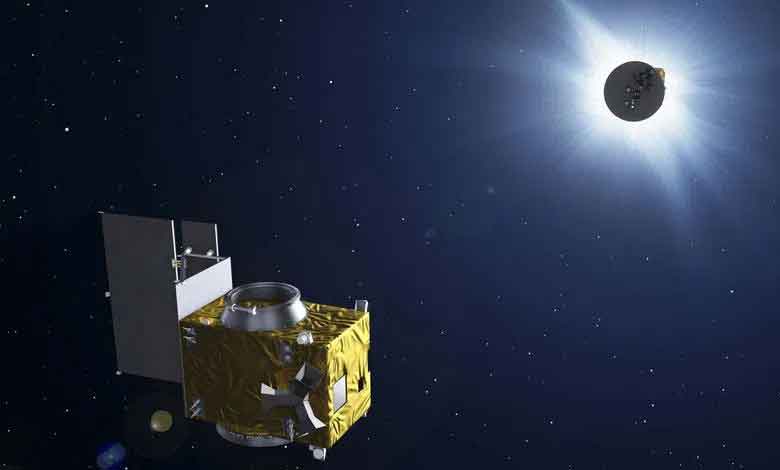ISRO Set to Launch ESA’s Proba-3 on December 4: A Mission to Unlock Sun’s Secrets
ISRO to launch ESA’s Proba-3 on December 4, 2024, marking a historic mission to study the Sun’s corona using advanced precision formation flying technology.

On December 4, 2024, the Indian Space Research Organisation ISRO Set to Launch ESA’s Proba-3 on December 4 mission to uncover the mysteries of the Sun’s corona. This ambitious mission represents a significant milestone in international space collaboration and scientific exploration, offering insights into one of the most challenging areas of solar study.
Overview of the Proba-3 Mission
Proba-3 is designed to study the Sun’s faint corona near the solar rim, a challenging feat due to the overwhelming brightness of the solar disk. The mission will utilize two precision-engineered satellites working in tandem to create a large, instrument-like structure in space called a solar coronagraph. This groundbreaking technology will allow scientists to observe the Sun’s outer atmosphere, or corona, with unparalleled accuracy.
Key Mission Details:
- Launch Date and Time: December 4, 2024, at 4:08 PM IST.
- Launch Site: Satish Dhawan Space Centre (SDSC), Sriharikota, Andhra Pradesh.
- Rocket Used: PSLV-XL, operated by ISRO.
- Orbit Details: Highly elliptical orbit, reaching a maximum altitude of 60,000 km and a minimum of 600 km.
Why Study the Sun’s Corona?
The Sun’s corona is a mysterious and dynamic layer of plasma that extends millions of kilometers into space. It is crucial for understanding phenomena such as solar flares and coronal mass ejections, which can disrupt Earth’s communication systems, satellites, and power grids. However, the corona is notoriously difficult to study due to its faintness and proximity to the intensely bright solar disk.
Proba-3’s Innovative Approach:
The Proba-3 mission will solve this challenge by using two satellites that work together with extraordinary precision. These satellites will maintain a fixed formation to block out the Sun’s bright disk, allowing detailed observation of the corona.
The World’s First Precision Formation Flying Mission
ESA describes Proba-3 as the “world’s first precision formation flying mission.” This innovative approach involves two satellites maintaining a 144-meter separation in orbit, creating a solar coronagraph that mimics a single large rigid structure.
How Formation Flying Works:
- Two-Satellite System: One satellite acts as a shadow-casting disk, blocking the Sun’s bright core, while the second satellite carries instruments to study the corona.
- Precise Positioning: The satellites maintain their formation with a level of accuracy unprecedented in space missions, utilizing advanced rendezvous and formation-flying technologies.
- Reduced Propellant Consumption: Operating at a peak altitude of 60,000 km minimizes Earth’s gravitational effects, reducing the fuel required for position adjustments.
This innovative technique not only enables a closer study of the corona but also demonstrates critical technologies for future space missions.
Launch Details: ISRO and ESA Collaboration
Proba-3 will be launched aboard ISRO’s Polar Satellite Launch Vehicle (PSLV-XL), a proven workhorse of the Indian space program. This mission highlights a deepening collaboration between ISRO and ESA, marking the first Proba mission launched from India since Proba-1 in 2001.
Logistics and Preparations:
- The Proba-3 satellites were transported from Belgium to the Chennai airport and subsequently moved to the Sriharikota spaceport by road.
- ESA teams are working alongside ISRO scientists at SDSC to prepare the satellites for launch, showcasing international teamwork in advancing space exploration.
Historical Significance and Future Implications
The Proba-3 mission is a testament to the growing synergy between Indian and European space agencies. It reflects India’s emergence as a global hub for cost-effective, reliable space launches and strengthens ESA’s capabilities in space science.
Significance of the Mission:
- Scientific Discovery: By enabling precise observations of the Sun’s corona, Proba-3 may lead to breakthroughs in solar physics.
- Technological Innovation: The mission demonstrates cutting-edge formation-flying techniques that could be pivotal for future multi-satellite missions.
- International Collaboration: The mission underscores the importance of global partnerships in tackling complex scientific challenges.
Technical Highlights of Proba-3
Proba-3’s design and execution set new benchmarks for space missions. Key technical features include:
Twin-Satellite System:
- Satellite 1: Equipped with a shadow disk to block the Sun’s core.
- Satellite 2: Carries advanced imaging equipment to capture detailed views of the corona.
Orbit Characteristics:
- A highly elliptical orbit ensures optimal observation periods while conserving fuel.
- The pair’s ability to descend to 600 km allows periodic calibration and data relay.
Advanced Technologies:
- Precision formation flying ensures the satellites maintain their relative position within millimeter accuracy.
- Advanced control systems enable real-time adjustments for optimal alignment.
What’s Next for Solar Research?
The insights gained from Proba-3 could have far-reaching implications for understanding solar activity and its effects on Earth. This mission represents a stepping stone for more ambitious solar exploration projects.
Potential Benefits:
- Improved Space Weather Predictions: A better understanding of solar activity can help protect satellites and power grids from geomagnetic storms.
- Enhanced Solar Physics Models: The data collected will refine models of solar behavior, aiding future missions and research.
Conclusion
The upcoming launch of ESA’s Proba-3 mission by ISRO marks a significant advancement in space exploration and international collaboration. By pushing the boundaries of solar observation and technological innovation, this mission promises to unlock the Sun’s secrets and pave the way for future scientific discoveries.
Stay tuned for updates as ISRO and ESA work together to deliver groundbreaking results from this historic mission.
